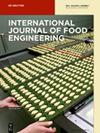Acerola byproducts microencapsulated by spray and freeze-drying: the effect of carrier agent and drying method on the production of bioactive powder
IF 1.4
4区 农林科学
Q3 FOOD SCIENCE & TECHNOLOGY
引用次数: 0
Abstract
Bagasse, peels and seeds from fruits are usually discarded as byproducts. However, these byproducts contain high levels of bioactive compounds. The objective of this study was to microencapsulate bioactive compounds from acerola byproducts by spray drying (SD) and freeze-drying (FD) using maltodextrin (MD), gum arabic (GA), and whey protein isolate (WPI) as carrier agents and then evaluate their stability in a gelatin food-model system. Moisture, solubility, and hygroscopicity of the powders were 5.02–10.05 %, 78.83–92 %, and 7.64–14.76 %, respectively. The best method for obtaining phenolic compounds and flavonoids was SD/GA, which yielded 1855.11 mg GAE/100 g and 289.38 μg/g of quercetin. The best method for obtaining anthocyanins was FD/GA, which yielded 33.85 mg of cy-3-glu/100 g. Powder dried by SD/MD could be used as a natural dye. Our results show that acerola byproducts has potential for reuse, and microencapsulation is a good technique for generating stable extracts.喷雾干燥和冷冻干燥法微胶囊化的巴西莓副产品:载体剂和干燥方法对生物活性粉末生产的影响
水果的蔗渣、果皮和种子通常作为副产品被丢弃。然而,这些副产品中含有大量生物活性化合物。本研究的目的是以麦芽糊精(MD)、阿拉伯树胶(GA)和乳清蛋白分离物(WPI)为载体,通过喷雾干燥(SD)和冷冻干燥(FD)将针叶树副产品中的生物活性化合物微囊化,然后评估其在明胶食品模型系统中的稳定性。粉末的水分、溶解度和吸湿性分别为 5.02-10.05%、78.83-92% 和 7.64-14.76%。获得酚类化合物和类黄酮的最佳方法是 SD/GA,其 GAE 产量为 1855.11 mg/100g,槲皮素产量为 289.38 μg/g。获得花青素的最佳方法是 FD/GA,每 100 克可获得 33.85 毫克 cy-3-glu。用 SD/MD 干燥的粉末可用作天然染料。我们的研究结果表明,针叶树副产品具有再利用的潜力,而微胶囊技术是产生稳定提取物的良好技术。
本文章由计算机程序翻译,如有差异,请以英文原文为准。
求助全文
约1分钟内获得全文
求助全文
来源期刊

International Journal of Food Engineering
FOOD SCIENCE & TECHNOLOGY-
CiteScore
2.50
自引率
0.00%
发文量
52
审稿时长
3.5 months
期刊介绍:
International Journal of Food Engineering is devoted to engineering disciplines related to processing foods. The areas of interest include heat, mass transfer and fluid flow in food processing; food microstructure development and characterization; application of artificial intelligence in food engineering research and in industry; food biotechnology; and mathematical modeling and software development for food processing purposes. Authors and editors come from top engineering programs around the world: the U.S., Canada, the U.K., and Western Europe, but also South America, Asia, Africa, and the Middle East.
 求助内容:
求助内容: 应助结果提醒方式:
应助结果提醒方式:


